 Rutgers Day 2016: On April 30, 2016 we celebrated the 250th Anniversary of Rutgers University on the Camden Campus. Our lab had Four stations:
Rutgers Day 2016: On April 30, 2016 we celebrated the 250th Anniversary of Rutgers University on the Camden Campus. Our lab had Four stations:
Urban heat Island Demonstration:
There are many characteristics of cities that make them very different from surrounding, less developed areas. These environmental stresses can impose health and economic costs on humans, but also act as strong filters for plant and animal diversity in urban ecosystems. One of the largest differences between urban and rural environments is the urban heat island effect. Cities can be over 5?F warmer than surrounding rural areas in the day and as much as 22? warmer in at night (US EPA). Street plantings can buffer this effect, and the cooling effect of vegetation can be observed in miniature simulations. In this demonstration, we used heat lamps, infrared thermometers, pavers, and potted plants to demonstrate the way that vegetation can buffer the effects of urban heat islands. We asked visitors to make predictions about how much difference plants make and then allow them to measure the temperature for themselves.
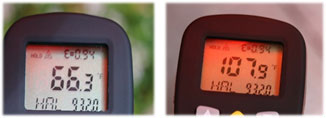
Actual readings taken at the same time at the surface of plants (left) and pavers (right).

Undergraduate Alexa Martinelli described the urban heat island effect to visitors.

Visitors used an infrared gun to measure the temperatures of the pavers and plants.
Do-it-yourself microscopes:
Faculty and students in many labs at Rutgers University-Camden use microscopes to conduct their research. We highlighted this research and showed people how they can make their own inexpensive stereoscopes. This project was led by an undergraduate in the Savage lab, Ourania Nikolaidis. She built a microscope with a laser pointer lens in a plexiglass case with a book light. She showed visitors how to use their smart phones to see magnified images. She also interviewed faculty and graduate students from the Biology Department at Rutgers University-Camden about how they use microscopy in their research and how microscopy influenced the development of knowledge in each PI’s area of expertise. Head over to the lab blog to read about some of these interviews and to see some high-resolution photographs from each lab!
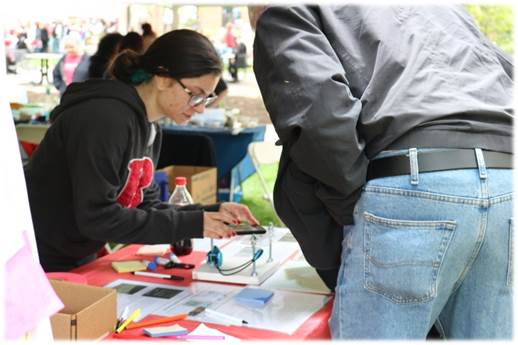
Undergraduate Ourania Nikolaidis demonstrated how to use her DIY microscope to visitors.

DIY microscope constructed by undergraduate Ourania Nikolaides. A clover leaf was used to demonstrate the effective magnification of the microscope
Post-it note activity – Ants in our daily lives:
From a very young age, humans interact with ants often in our daily lives. However, we know very little about their biology in urban environments. One of the key research goals in the Savage lab is to understand the ecology of ants living in cities. In this activity, we asked visitors to share their observations of ants in their own backyards and neighborhoods. We had a large poster about urban ant biology (made by Magdalena Sorger), lots of post-it notes, and markers. Visitors wrote down (or drew pictures of) their observations of ants on a post-it (anonymously), and adhered it to the ant poster. At the end of the day, the poster was completely covered with post-it notes-a visual depiction of interactions between the humans of Camden and their local environment.

Visitors wrote (or drew pictures of) their observations of ants in their daily lives.

Ant poster at the end of the day. Zoomed in post-its depicted below.
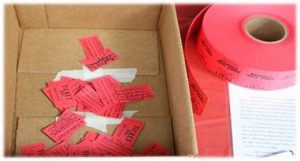
Everyone who participated in the post-it note activity was entered into a raffle to win the DIY microscope constructed by undergraduate Ourania Nikolaides

Ant feeding trials:
One of the reasons that ants have such strong effects on nearly every terrestrial ecosystem on the planet is that they have diverse diets and opportunistic feeding habits. Previous research has shown that what ants choose to eat at baiting stations with different types of food indicates the status of their colonies. In cities, ants often feed on human foods, but they clearly did not evolve eating potato chips and hot dogs. Assessing the nutritional ecology of urban ants is a current project in the Savage lab. We are just starting to understand the consequences of a processed diet for ants, both from the perspective of ant biology and from the perspective of ecosystem services performed by ants. In this demonstration, we replicated a real feeding trial from our lab. We set out bait stations with human foods (potato chips, cookies, bananas & hot dogs) and ‘ant health food’-crickets. We asked visitors to count the numbers of ants at each bait type and regularly tweeted out the results.
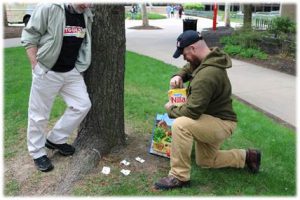
Undergraduate John Rapacz set out the baits ~9:00 AM.

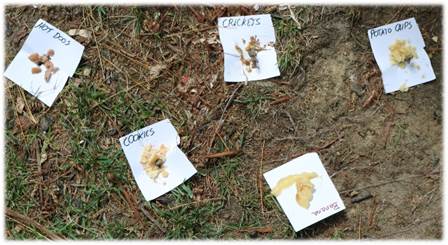
Hot dogs, cookies, potato chips, banana, & crickets were placed in grass and on the sidewalk.